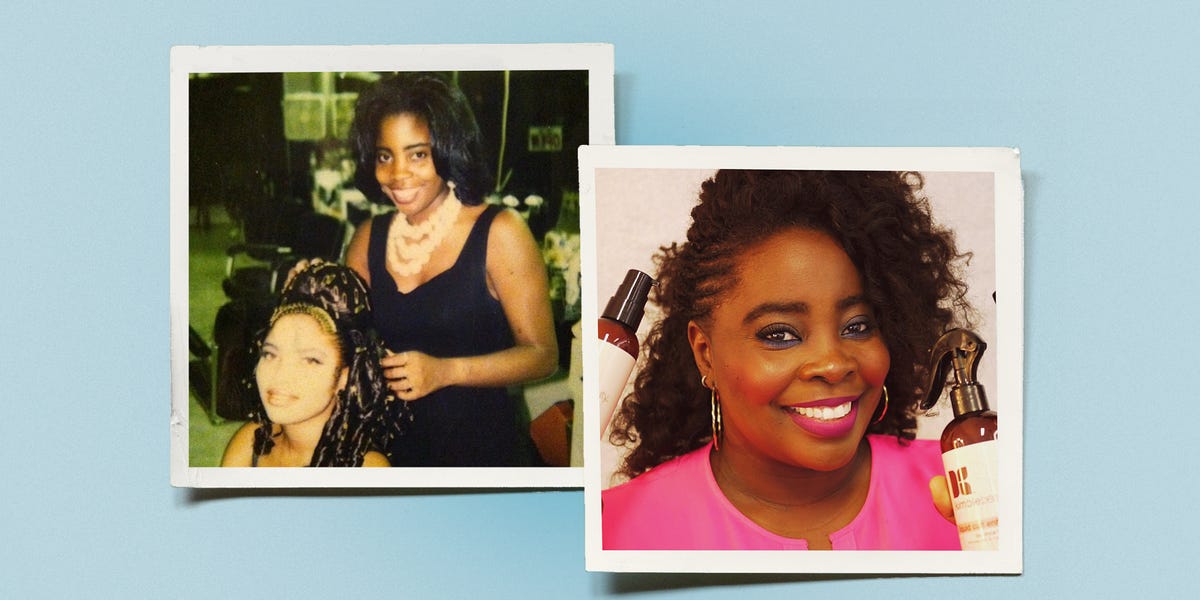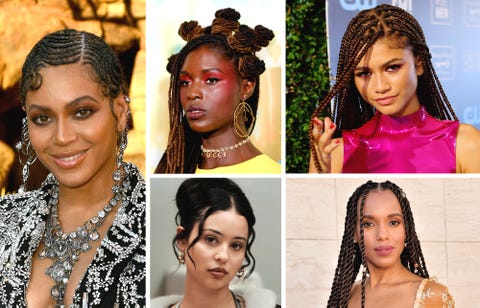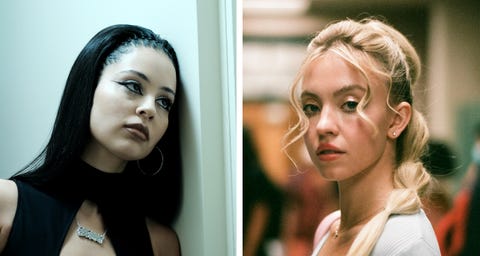For decades, Hollywood stars like Beyoncé, Mary J. Blige, Brandy, Zendaya, and Shakira have sought out Kim Kimble’s gifted hands and sharp eye. The trusted hairstylist has become a celebrity favorite for help achieving impeccable glam, but also for guidance when looking to experiment with their self-expression.
As a third-generation hairstylist who grew up in salons, Kimble has grown deeply attuned to the power, vulnerability, and emotion that exist beneath the surface of our hair. The ways it can make or break a person’s day, impact mental health and confidence, and the connection one can feel by just sitting in a stylist’s chair.
Kimble’s illustrious 30-year career has included working as a shampoo girl for her mother, crafting next-level hair sculptures, and competing at hair show competitions in the 90s—which prepared her for the epic hair designs she’d go on to do in the 1997 cult classic B.A.P.S. Then there’s opening a West Hollywood salon, starring in a hit reality series, L.A. Hair, for five seasons about running her salon, manufacturing her own products—including a Walmart line for natural hair that coincided with Kimble’s own natural hair journey, a Youtube show, and serving as a department head on a number of TV shows and films, like the second season of HBO’s smash hit Euphoria.
Her journey with hair, others, and her own is extensive and powerful. It’s filled with moments of reflection and truly illuminates the connection between hair and wellness. Kimble chatted with ELLE about the many emotions a hair journey can encompass, showcasing the Euphoria characters’ chaotic inner worlds through their hair in season 2, and the personal journey of learning to love her natural hair as an adult.
Something I’m realizing more with time is how much of what we experience internally as human beings—sadness, fatigue, anxiety, desire, and so on—manifests in our hair choices and routines, or lack thereof. Is that something you’re constantly reminded of in your work?
When I got into the business, I didn’t know how emotionally tied people were going to be to their hair until I got into doing it. One big example is all of the issues with people’s hair that came from the pandemic during quarantine. I know a girl who didn’t comb her hair for an entire year. One, I think she was depressed, but two, she’s like, “Nobody can do my hair because of the pandemic. I don’t know who to go to. I don’t know what to do.” But why couldn’t you comb your own hair? But it’s just the mental state of what people were going through. There has been a lot of hair loss, a lot of hair breakage and damage, and a lot of problems when it comes to hair. People trying to do it and some people not trying to do anything about it. Just our regular, everyday trauma, and then on top of it we have pandemic trauma.
It seems like doing hair can include a lot of emotional labor. I know I’ve definitely heard and experienced deep talks in a stylist’s chair. How do you protect your energy and practice self-care?
A lot of clients get in your chair and they kind of almost look at you as a psychiatrist in a way. They sit down and they start discussing their problems. One thing I learned to do as a hairstylist, so I wouldn’t take on all that energy by myself is, I hear but I don’t hear. I don’t feel like I always have to have an opinion. I had to learn that because you take on too many people’s emotional issues.
Most times, people don’t really want your opinion. They just want to get it out. You can kind of tell and you just go, “Mm-hmm. Yeah, yeah.” Just trying to also protect yourself and your space—because I do take things on and I get emotional too when people are going through stuff. You know, just kind of let it bounce off and push it back out there in the world. You can’t take on a lot of people’s energy and their issues and their things. That’s my recommendation for people who are in that position often.
You’ve been a department head on a number of TV shows, feature films, music videos, and Beyoncé ~experiences~ since the ‘90s. Most recently you helmed all things hair on the second season of Euphoria. Can you give us a glimpse into showing the emotional journey of TV’s most chaotic teens through their hair?
The beauty of doing hair for films and television is it’s really about who that character is, what that character’s going through, and the progression of that character sometimes. So it’s all in the writing. The process is a collaboration with the director, costumes, makeup, and actor.
For example, Rue is on drugs. She’s not really one of those teenagers that’s into her hair like that. Sometimes she’ll try, but not really. It never hits it. She’s not in a mental state of really loving herself because she’s on drugs and suffering from her drug abuse, and so that shows in her hair. She’s not really grooming her hair. She’s just like, “You know what, I’m getting up. I’m looking for my next fix. And I ain’t really thinking about what my hair is looking like right now.” So [her hair] tells that story.
I loved how you showed Cassie’s spiral through her meticulous hairstyles.
That was Sam Levinson. That’s something he specifically pointed out that he wanted. He said, “Hey, I want to show this progression of her spiraling out of control where we’re going to do different hairstyles and come up with some styles that show that she was trying to…” Her whole thing is that she’s trying to get attention and stand out. She’s kind of losing her mind over this boy.
So definitely a lot of her hair showed her state of mind. There was also a scene where now she’s trying to be someone who Nate wants her to be. So she dyed her hair more blonde, and she becomes his doll. That’s kind of how Sam described it. She becomes a sort of Malibu Barbie.
If your hair could talk, what’s a lesson it would share from your own hair journey?
Recently, I really restructured my entire hair or being. I used to do a lot of extensions and straighten my hair and chemically alter my hair to make it look more straight. But the last couple of years, I’ve been on a natural hair journey. Learning how to love my own hair. I hated my hair growing up. I was like, This hair is the most difficult hair in the world to deal with. It was even like, God, why? Why?
I think that’s a common journey for so many, you’re definitely not alone in that.
Right. But, I learned that God says, “You’re beautiful.” So you’re well made. And then I started seeing all these bloggers that wore natural hair. And I said, “Well now their hair is beautiful.” They have figured out a way to kind of work with their own hair. And I even recently created a natural hairline that we launched in Walmart. As I was working on it, I said, “This is the perfect time for me to experience this and go through this hair journey of rocking my natural hair.” And I enjoyed it. People liked it. It gave me a chance to actually be able to feel what that customer feels, and know what she wants when it comes to rocking natural hair.
I had a lot of customers on social media asking, “What can I do for my 4C hair?” and “What kind of product can I use for this and that?” So when creating these products, I said, you know what, I have that same hair, let me figure it out. I cut my hair and started wearing it naturally. I started realizing, “Oh, my hair is different. It’s nice. It just needs the right techniques and the right products. Okay. Now I finally appreciate my texture and my hair.”
Now it’s growing out so I’m going through a transition, which is frustrating. Because my next journey is hair growth. So I’m cutting it now because now I’m on a journey to grow. I do like to switch it up (braids, twists, weaves, natural hairpieces, etc). I don’t want the same look all the time. But now I know how to work with my hair and it does make me feel better about myself. And I wish, gosh, I wish years ago I knew this.
When you reflect on your incredible career and the legacy of Kim Kimble, what’s one thing you hope sticks with people?
The quality of my work. Even though I have a lot of work, quantity, probably helped too. The more you do something, the better you get at it. Some people don’t care about that these days, and they’re not really into perfecting or even telling a story with their hair.
I started off in a salon at a beauty college. I did different phases. I went through a phase of just educating. Then competing. Then I got into TV entertainment. Then manufacturing my own products and things. Going from behind the camera to in front of the camera.
I’ve had an amazing journey and it shows what a hairstylist is, when you love what you do and you really focus on what you do and you are authentic and true to what you do—look at all the options of what you can do. I’ve had so many different, great opportunities. I just want to continue to grow and see where I go next.
This content is created and maintained by a third party, and imported onto this page to help users provide their email addresses. You may be able to find more information about this and similar content at piano.io


